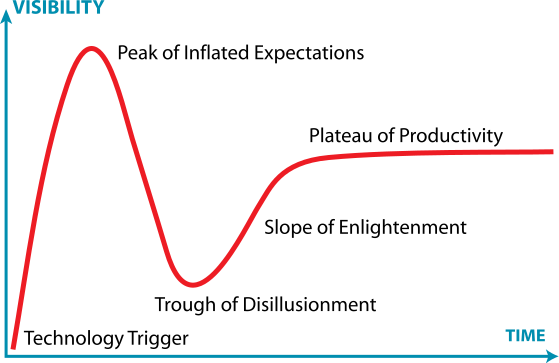
Decoding AI Hype for Teaching and Learning
The term “hype” refers to an intense anticipation of or response to a particular topic, often amplified and exaggerated by media coverage and public discourse. In the context of generative AI, a subset of artificial intelligence, hype encompasses inflated expectations and predictions (positive and negative) about the technology’s potential impact and future developments on college education.
Generative AI is making waves in the media. But why is there so much hype? Gartner’s Hype Cycle (Perri, 2023) is a theory that provides a graphical representation of five phases of the lifecycle of technology trends. Each phase represents a different stage in the public perception and adoption of a new technology. The stage of the greatest hype for new technology is the “Peak of Inflated Expectations,” described as a period in which “media tend to focus on potential big stories,” both positive and negative (Steinert & Leifer, 2010, p.2). The cycle continues through the “Trough of Disillusionment,” the “Slope of Enlightenment,” and the “Plateau of Productivity.”

Since 2023, generative AI has been located at the very top of Gartner’s hype cycle, the “Peak of Inflated Expectations,” and is set to remain there for two to five years. While the hype cycle is a conceptual idea rather than an empirical model (Steinert & Leifer, 2010), as we encounter various sources describing the “breakout growth” or “work disruption” of AI in education and industry it is helpful to consider the “hype factor.”
The impact of generative AI on college education will be significant, but it is not yet fully known. On one hand, “Generative AI is a tool we can use to perform tasks with such efficiency that we never thought possible” (World Economic Forum, 2022, para. 4). On the other hand, AI leader Daphne Koller reminds us of the limitations of generative AI, as their LLMs “are entirely predictive engines; they’re just doing associations” (in Chowdhury, 2024, para. 23). This underscore the importance of teaching students about what AI can and cannot do as they learn in their educational programs.
Beyond academia, generative AI is also transforming various industries. In Forbs, Galer (2022) highlights that “AI’s new business models can optimize the convergence of the digital world with the physical world and drive the ‘anything as a digital service’ trend” (para. 6). However, Shine and Whiting (2023) claim that “Around 40% of all working hours could be impacted by AI large language models (LLMs) such as ChatGPT-4” (para. 5).
Speculative predictions and exaggerated viewpoints may not accurately reflect what AI can and will do. “[D]espite all the hype,” Chowdhury writes, “AI experts have been adamant […] that AI – in its current form anyway – is pretty limited in scope” (2024, para.4). AI may be driving workforce transformation, but core industry knowledge, skills, and attitudes remain vital to students’ college education.
How can we, as educators, decode what we are hearing and seeing about generative AI? Here are some ideas.
- Embrace Curiosity: AI in education is a rapidly evolving field, and feeling excited and overwhelmed is natural. Stay curious and open-minded about the potential of AI.
- Consider the “Hype Factor”: It’s important to evaluate the information you come across about AI with a critical eye. Check the facts, consider the source, and temper expectations.
- Foster Collaboration: You’re not alone on this journey. Reach out to colleagues and students. Share your insights and learn from their experiences with AI.
- Experiment at Your Own Pace: There’s no one-size-fits-all approach to using AI in your teaching. Get college support to experiment with AI tools at your own pace and comfort level.
- Maintain a Balanced Perspective: While staying informed about the latest developments in AI is important, remember that AI is a tool, not a replacement for human skills and expertise. Stay optimistic but also realistic about the potential of AI.
Sifting through the buzz surrounding generative AI is beneficial for us. It’s equally good for students to witness us posing inquiries, withholding immediate conclusions, and seeking expert insights about generative AI, rather than contributing to the existing hype.
Note: This post was written in collaboration with ChatGPT 4.0, which assisted with finding selected resources and forming an initial outline draft based on the author’s detailed criteria. Following this, the author further revised.
References
Chowdhurty, H. (2024). Don’t worry — the machines won’t be as smart as humans for a long time, because they’ve still got a lot to learn. Business Insider.
Copilot. (2024). Microsoft Copilot. [Large language model]. https://copilot.microsoft.com/
Galer, S. (2022). AI Trends 2022: Spare Us The Hype, We Want Business Results. Forbes.
Perri, L. (2023). What’s New in the 2023 Gartner Hype Cycle for Emerging Technologies. Gartner, Inc.
World Economic Forum. (2022). Life after hype: How AI is transforming industries, economies. World Economic Forum.
Shine, I., & Whiting, K. (2023). The jobs most likely to be lost and created because of AI. World Economic Forum.
Steinert, M. & Leifer, L. (2010). Scrutinizing Gartner’s hype cycle approach. Technology Management for Global Economic Growth (PICMET), 2010 Proceedings of PICMET ’10, 1 – 13.






